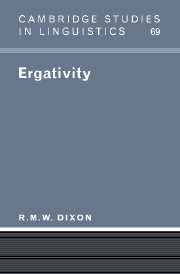Book contents
- Frontmatter
- Contents
- Preface
- Acknowledgements
- Appeal
- List of abbreviations
- 1 Introduction
- 2 Syntactically based and semantically based marking
- 3 Intra-clausal or morphological ergativity
- 4 Types of split system
- 5 The category of ‘subject’
- 6 Inter-clausal or syntactic ergativity
- 7 Language change
- 8 The rationale for ergativity
- Appendix: A note on theoretical models
- References
- Index of authors
- Index of languages and language families
- Subject index
7 - Language change
Published online by Cambridge University Press: 06 July 2010
- Frontmatter
- Contents
- Preface
- Acknowledgements
- Appeal
- List of abbreviations
- 1 Introduction
- 2 Syntactically based and semantically based marking
- 3 Intra-clausal or morphological ergativity
- 4 Types of split system
- 5 The category of ‘subject’
- 6 Inter-clausal or syntactic ergativity
- 7 Language change
- 8 The rationale for ergativity
- Appendix: A note on theoretical models
- References
- Index of authors
- Index of languages and language families
- Subject index
Summary
Particular linguistic changes generally proceed in a single direction. For example, a preposition or postposition may develop into an affix, and a velar or labial stop may lenite to the semi-vowel w (changes in the opposite directions are either unknown or extraordinarily rare). Through a combination of specific changes a language can shift from one typological profile to another. There is nothing unidirectional about changes at this level (see Croft 1990: 229). Any type of language – in terms of any typological parameter – can change into another type, and back again. (If this were not the case all languages would be inexorably moving in a single direction, towards some ‘ultimate’ language typé)
We have written records going back at the most five thousand years (and then for very few languages). For a number of language families, scholars have reconstructed aspects of a proto-language and suggested an approximate date for this – all of these dates are within the last ten thousand years. Yet language is presumed to have been spoken by Homo sapiens during many tens (perhaps hundreds) of millennia. We thus have available for study only a fraction of the history of human language. It is, however, enough to perceive a clearly cyclic pattern of change.
Information
- Type
- Chapter
- Information
- Ergativity , pp. 182 - 206Publisher: Cambridge University PressPrint publication year: 1994
